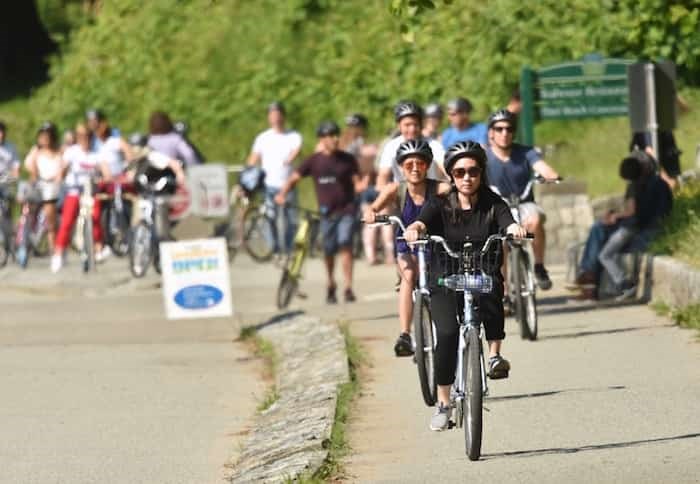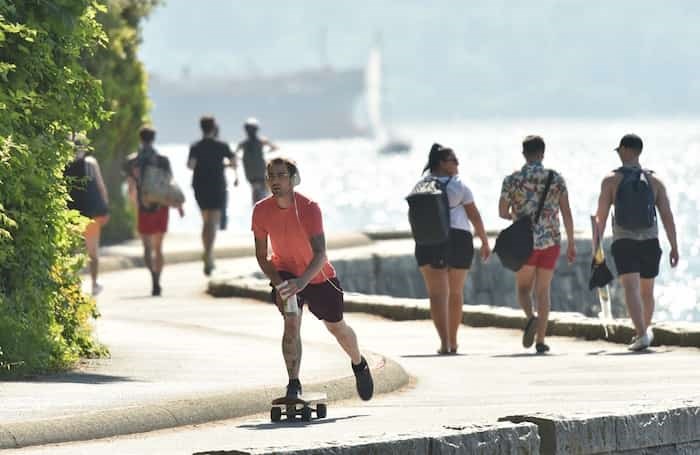 Of the myriad of safety issues found on the Seawall, cyclist speed is at the top of the list along with people travelling the wrong way. Photograph By Dan Toulgoet
Of the myriad of safety issues found on the Seawall, cyclist speed is at the top of the list along with people travelling the wrong way. Photograph By Dan Toulgoet
Your time to get a summer body worthy of endless Instagram vanity is fleeting.
Summer is here, wildfire smoke is not far off and the seasonal fitness enthusiasts among us are filling local gyms.
Bike to Work Week has come and gone, and you feel shame.
Fear not. You have a 28-kilometre gem that hugs much of the city’s oceanfront, and accessing it is as free as the day is long.
But with estimates suggesting eight to 10 million people use the �鶹��ýӳ��Seawall annually, there is need for decorum and some rules of engagement.
To that end, the Courier spoke with senior park board staff, a veteran park ranger and a retired semi-pro cyclist in an attempt to promote harmony among all users.
Slow it down
Chris Penton is a lead park ranger who’s in Stanley Park all the time. He and everyone else the Courier spoke to cited cycling speed as issue number one.
Bikes aren’t supposed to exceed 15 km/h anywhere on the Seawall or in Stanley Park, but try telling that to Lance Armstrong wannabes of the world.
“We’ve had very serious accidents with bikers who whip around a corner on a slick road after it’s rained travelling too fast and hitting barriers,” Penton said. “They’re rushed to the hospital. Lots of head injuries.”
The park board made a concerted effort last year to double down on precisely that messaging — that the Seawall is for everyone and no two bike rides are the same.
“It’s a recreational cycling route — you can expect young children with their caregivers or tourists who maybe haven’t been on a bike for a little while,” said Tiina Mack, the park board’s manager of park development. “Those folks who are quite fit and do it for exercise — that’s awesome, too. But be mindful this is an all-ages, all-abilities recreation route.”
Follow direction
The need for speed is one thing, but Penton also sees plenty of scofflaws willfully ignoring the one-way travel transition point near Second Beach. Some are tourists, but the vast majority of the directionally challenged are locals who know better.
 Of the myriad of safety issues found on the Seawall, cyclist speed is at the top of the list along with people travelling the wrong way. In this photo, the skateboarder is not only on the pedestrian path, he’s also travelling the wrong direction on what is a one-way portion of the Seawall. Photo Dan Toulgoet.
Of the myriad of safety issues found on the Seawall, cyclist speed is at the top of the list along with people travelling the wrong way. In this photo, the skateboarder is not only on the pedestrian path, he’s also travelling the wrong direction on what is a one-way portion of the Seawall. Photo Dan Toulgoet.
This happens frequently, despite the fact that Rawlings Trail takes you right to Third Beach without having to loop around the entire park.
“They totally disregard those suggestions and they swing around Second Beach to Third Beach on their bikes,” Penton said. “That’s the most problematic area.”
Third Beach itself can also be problematic, and that’s in spite of the weekly drum circles every Tuesday night. Rangers and police maintain a regular presence at the patchouli fests to keep an eye on litter, drinking and smoking.
“[Attendees] know there’s no smoking on the beach so what do they do? They go into the forest to smoke, which is more of a problem for us,” Penton said.
Electric outage
Scofflaws, smoking and speed are all old hat for Penton, but a new menace is also emerging in the form of electric bikes. Penton has even seen Vespas and other motorized two wheelers on the Seawall.
None of that is allowed and the rangers get all kinds of grief for it. One recent interaction with an electric bike owner ended with Penton being told to "f*** off.” Another rider tried to justify his e-bike’s presence on the Seawall by saying it’s no different than a motorized scooter used by those with mobility challenges.
“The common sense that’s missing, I can’t even believe it sometimes,” Penton said.
Crowd work
Given their line of work and sheer volume of people they interact with, park rangers are used to de-escalating situations. They can’t ticket for anything other than smoking violations, so they have to use their words. Penton starts by asking someone if they have a moment to talk about their no-no, and then explains why that action negatively impacts the park. A lot of times people respond by saying the city is run by idiots. Penton counters that by encouraging them to vote or use feedback channels such as calling 311 or emailing the park board directly.
Penton gets some respite when it rains. In fact, he says the best the time to hit up the Seawall is when the skies open up — it’s far less busy and wildlife sightings are aplenty.
Mornings are busy with joggers, and noon until 5 p.m. is peak chaos among all user groups. Don’t even bother Friday to Sunday at around 3 p.m., particularly in the summer months.
“With evenings, it’s less people but more non-compliant people,” Penton said. “Whereas at 3 p.m., there are so many people and they’re all just lost because it’s their first time here.”
Pro tips
Boris Martin can’t be too picky with when he gets his sweat on. He’s a new dad and a business owner who’s on the Seawall at least five times a week both as a runner and a cyclist.
A former semi-pro cyclist and owner of mobile bike repair business velofix, Martin sees it all due to the sheer amount of time he spends on the entire span of the Seawall.
Cyclist speed is a huge issue, but so too is tech — people stopping to take selfies on the bike path, others who are completely buried in their cellphones and oblivious to the crush of humanity around them.
Pro tip: Stopping for any reason in the bike lane is a cardinal sin, and you should never do it. If you need a drink or 300 photos documenting your journey towards self-improvement, move to the pedestrian path or the infinitely available patches of beach, grass or whatever else.
“If you’re riding your bike, you cannot just stop through a blind curve, or anywhere, to take a selfie,” Martin said. “You should take that selfie. That’s beautiful. But get off your bike and go to the pedestrian area.”
Martin cites three pinch points along the route that are always busy, always teeming with both bikes and pedestrians: outside of Science World, near the Cactus Club on Beach Drive and all of Olympic Village. Situational awareness in those areas is paramount, which is why Martin never runs or cycles with earphones in.
“Maybe some people are better at this than I am, but I feel very limited and unaware of what’s going on,” he said.
Martin is a realist when it comes grievances on the Seawall or anywhere where bikes interface with other modes of getting around. Slow movers should stay on the right, if you pass, move to the left. Stay in your lane and don’t stray from the path. Keep an eye on your kids.
And remember, getting angry doesn’t do anyone any good.
“Pedestrian and bike safety is a shared responsibility. That has to be the lens we’re looking through on this,” Martin said. “Everyone is always quick to point fingers but we all need to have our heads on a swivel.”


